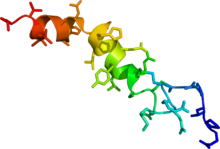Orexins
| Prepro-orexin | |||||||||
|---|---|---|---|---|---|---|---|---|---|

|
|||||||||
| Identifiers | |||||||||
| Symbol | Orexin | ||||||||
| Pfam | PF02072 | ||||||||
| InterPro | IPR001704 | ||||||||
| SCOP | 1cq0 | ||||||||
| SUPERFAMILY | 1cq0 | ||||||||
| OPM superfamily | 154 | ||||||||
| OPM protein | 1wso | ||||||||
|
|||||||||
| Available protein structures: | |
|---|---|
| Pfam | structures |
| PDB | RCSB PDB; PDBe; PDBj |
| PDBsum | structure summary |
| orexin (hypocretin) neuropeptide precursor | |
|---|---|

|
|
| Identifiers | |
| Symbol | HCRT |
| Alt. symbols | PPOX, OX |
| Entrez | 3060 |
| HUGO | 4847 |
| OMIM | 602358 |
| RefSeq | NM_001524 |
| UniProt | O43612 |
| Other data | |
| Locus | Chr. 17 q21 |
Orexin, also called hypocretin, is a neuropeptide that regulates arousal, wakefulness, and appetite. The most common form of narcolepsy, in which the sufferer briefly loses muscle tone (cataplexy), is caused by a lack of orexin in the brain due to destruction of the cells that produce it.
There are approximately 70,000 orexin producing neurons in the human brain that project from the lateral hypothalamus to neurons and brain regions that modulate wakefulness. However, the axons from these neurons extend throughout the entire brain and spinal cord, where there are also receptors for orexin.
Orexin was discovered in 1998 almost simultaneously by two independent groups of rat-brain researchers. One group named it orexin, from orexis, meaning "appetite" in Greek; the other group named it hypocretin, because it is produced in the hypothalamus and bears a weak resemblance to secretin, another peptide. The use of both terms is now a practical necessity, as hypocretin is used to refer to the genetic products and orexin is used to refer to the protein products.
There are two types of orexin: orexin-A and -B (hypocretin-1 and -2). They are excitatory neuropeptides with approximately 50% sequence identity, produced by cleavage of a single precursor protein. Orexin-A is 33 amino acid residues long and has two intrachain disulfide bonds; orexin-B is a linear 28 amino acid residue peptide. Although these peptides are produced by a very small population of cells in the lateral and posterior hypothalamus, they send projections throughout the brain. The orexin peptides bind to the two G-protein coupled orexin receptors, OX1 and OX2, with orexin-A binding to both OX1 and OX2 with approximately equal affinity while orexin-B binds mainly to OX2 and is 5 times less potent as OX1.
...
Wikipedia
